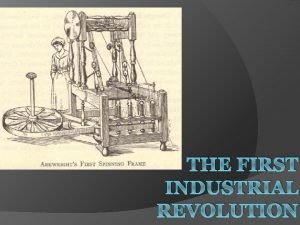Mc Kay Crowston WiesnerHanks Perry A History of






























































- Slides: 62

Mc. Kay • Crowston • Wiesner-Hanks • Perry A History of Western Society Twelfth Edition CHAPTER 19 Revolution in Politics 1775– 1815 Copyright © 2017 by Bedford/St. Martin’s Distributed by Bedford/St. Martin's/Macmillan Higher Education strictly for use with its products; Not for redistribution.


I. Background to Revolution A. 1. 2. 3. 4. 5. Social Change Rights of nobles Middle-class privileges Taxed peasants and urban laborers Urban population and inflation rose Poor struggled while investors grew rich

I. Background to Revolution A. Social Change 7. Mixed-caste elite and the bourgeoisie 8. Ancient privileges seemed intolerable 9. Racial regimes 10. Enforced racial privilege

I. Background to Revolution B. Growing Demands for Liberty and Equality 1. “Liberals” 2. The Declaration of the Rights of Man and of the Citizen 3. Government run by the will of the people 4. Ambiguous idea of equality 5. Did not believe in economic equality 6. Revolutionary demands

I. Background to Revolution B. Growing Demands for Liberty and Equality 7. Referenced John Locke 8. Also the baron de Montesquieu 9. Restrictions on representative government 10. Appealed to nobility and educated middle classes 11. Poor had little time to plan for reform 12. Some demands for a fuller realization of liberal notions

I. Background to Revolution C. The Seven Years’ War 1. Prussia survived attempt to re-establish Habsburg rule 2. War broke out in North America between the French and British colonies 3. The 1763 Treaty of Paris 4. Britain, the leading European power 5. France retained Caribbean colonies 6. Both governments raised taxes to repay loans





II. The American Revolutionary Era, 1775 – 1789 A. 1. 2. 3. 4. The Origins of the Revolution Seven Years’ War doubled the British national debt Parliament passed the 1765 Stamp Act Colonists protested the Stamp Act Proclamation prohibiting colonists from settling west of the Appalachian Mountains 5. Questions over British authority over America 6. British administration seen as threat to American liberties

II. The American Revolutionary Era, 1775 – 1789 A. The Origins of the Revolution 7. Freedoms of Americans 8. Indpendent farmers; no hereditary nobility 9. The “Tea Party” in Boston (1773) 10. The Coercive Acts 11. Colonial assemblies 12. The First Continental Congress 13. Fighting began at Lexington and Concord (1775)


II. The American Revolutionary Era, 1775 – 1789 B. 1. 2. 3. 4. Independence from Britain Thomas Paine, Common Sense (1775) The Declaration of Independence Civil War of Patriots against Loyalists Many Loyalists fled to Canada

II. The American Revolutionary Era, 1775 – 1789 B. 5. 6. 7. 8. Independence from Britain More democratic revolution French supplied guns and gunpowder The marquis de Lafayette (1757 – 1834) Spanish and Dutch declared war on Britain

II. The American Revolutionary Era, 1775 – 1789 C. 1. 2. 3. Framing the Constitution The Constitutional Convention (1787) Frameworks of checks and balances Power of federal government checked by individual states 4. Antifederalists 5. Bill of Rights

II. The American Revolutionary Era, 1775 – 1789 D. 1. 2. 3. 4. 5. 6. Limitations of Liberty and Equality before the law, not equal rights Emancipation laws in the North Three-Fifths Compromise Better representation for the South in Congress Native American lands Women contributed to the American Revolution but did not receive voting rights

III. Revolution in France, 1789 – 1791 A. 1. 2. 3. 4. Breakdown of the Old Order King Louis XV (r. 1715 – 1774) and national debt No central bank or paper currency Increasing taxes meant reforming the system Louis XVI (r. 1774 – 1792)

III. Revolution in France, 1789 – 1791 B. 1. 2. 3. 4. The Formation of the National Assembly Session of the Estates General Local assemblies elected representatives Consensus in calls for a constitutional monarchy Debates over how the estates should vote


III. Revolution in France, 1789 – 1791 B. The Formation of the National Assembly 5. abbé Emmanuel Joseph Sieyès, What is the Third Estate? 6. One vote granted to each estate 7. The National Assembly and the Tennis Court Oath (1789) 8. Louis XVI’s response


III. Revolution in France, 1789 – 1791 C. 1. 2. 3. 4. Popular Uprising and the Rights of Man Soaring bread prices and inflation Storming of the Bastille (July 14, 1789) Peasants rose up against their lords The Declaration of the Rights of Man and of the Citizen (1789) 5. Women marched to Versailles demanding bread



III. Revolution in France, 1789 – 1791 D. A Constitutional Monarchy and Its Challenges 1. Abolishment of the French nobility in 1790 2. Lawmaking power with the National Assembly 3. Women and the constitution 4. Olympe de Gouges, Declaration of the Rights of Woman (1791)

III. Revolution in France, 1789 – 1791 D. A Constitutional Monarchy and Its Challenges 5. Abolishment of guilds and workers’ associations 6. Reorganization of country’s religious life 7. Sold church property 8. Established a national church 9. The pope condemned the Assembly’s actions 10. Educated classes vs. common people


IV. World War and Republican France, 1791 – 1799 A. The International Response 1. Edmund Burke, Reflections on the Revolution in France (1790) 2. Mary Wollstonecraft, A Vindication of the Rights of Man (1790) 3. A Vindication of the Rights of Woman (1792) 4. The Declaration of Pillnitz

IV. World War and Republican France, 1791 – 1799 A. 5. 6. 7. The International Response The Jacobins Prussia and Austria vs. the French King Louis imprisoned

IV. World War and Republican France, 1791 – 1799 B. The Second Revolution and the New Republic 1. Radicalization of the revolution 2. The September Massacres 3. France declared a republic 4. The National Convention and Jacobins 5. Louis and Marie Antoinette executed (1793) 6. French occupation of the Austrian Netherlands

IV. World War and Republican France, 1791 – 1799 B. The Second Revolution and the New Republic 7. French armies like foreign invaders 8. France at war with almost all of Europe 9. Peasants revolted 10. The san-culottes, the Mountain, and the Girondists 11. The Committee of Public Safety (1793)




IV. World War and Republican France, 1791 – 1799 C. 1. 2. 3. Total War and the Terror Emergency form of socialism The Reign of Terror (1793 – 1794) Jacobins suppressed women’s role in politics; Olympe de Gouges executed for sedition 4. Fervor of nationalism 5. French armies victorious by spring 1794




IV. World War and Republican France, 1791 – 1799 D. 1. 2. 3. 4. 5. 6. Thermidorian Reaction and the Directory Extension of the Terror Robespierre executed in July 1794 Thermidorian reaction The Directory The national elections of 1797 A coup d’état ended the Directory



V. The Napoleonic Era, 1799 – 1815 A. 1. 2. 3. 4. 5. Napoleon’s Rule of France Napoleon Bonaparte (1769 – 1821) “Confidence from below, authority from above” First consul of the republic The Napoleonic Code (1804) Bank of France established in 1800

V. The Napoleonic Era, 1799 – 1815 A. 6. 7. 8. 9. Napoleon’s Rule of France Centralized state The Concordat of 1801 Women lost gains made in the 1790 s Curtailed freedoms


V. The Napoleonic Era, 1799 – 1815 B. 1. 2. 3. 4. 5. 6. 7. Napoleon’s Expansion in Europe French armies defeated the Austrians Treaty of Lunéville (1801) Treaty of Amiens (1802) Battle of Trafalgar (1805) Napoleon proclaimed emperor in late 1804 German Confederation of the Rhine Treaties of Tilsit in 1807


V. The Napoleonic Era, 1799 – 1815 C. 1. 2. 3. 4. The Grand Empire and Its End Napoleon’s Grand Empire Napoleon’s Continental System Revolt in Spain in 1808 Continental System backfired

V. The Napoleonic Era, 1799 – 1815 C. 5. 6. 7. The Grand Empire and Its End Invaded Russia in June 1812 Retreat from Russia; military disaster European patriots called for a “war of liberation”; Napoleon abdicated in 1814


V. The Napoleonic Era, 1799 – 1815 C. The Grand Empire and Its End 8. Treaty of Chaumont 9. Restoration of the Bourbon dynasty 10. Napoleon escaped from Elba (1815) 11. Napoleon defeated at Waterloo (1815) 12. Napoleon imprisoned on island of St. Helena


VI. The Haitian Revolution, 1791 – 1804 A. Revolutionary Aspirations in Saint. Domingue 1. Social tensions in Saint-Domingue 2. Creoles developed their own interests 3. The 1685 Code Noir (Black Code) 4. Colonial administration began rescinding the rights of free people of color

VI. The Haitian Revolution, 1791 – 1804 A. Revolutionary Aspirations in Saint. Domingue 5. Reforms in France inspired hope for enslaved and free people of color 6. Creole elite looked to representative government 7. France reaffirmed monopolies over colonial trade 8. Vincent Ogé and his army 9. Political rights granted to free people of color born to two free parents with property 10. Colonial governor refused to enact it


VI. The Haitian Revolution, 1791 – 1804 B. The Outbreak of Revolt 1. Slave revolts in August 1791 2. Full citizenship rights extended to free men of color (1792) 3. Toussaint L’Ouverture (1743 – 1803) 4. France abolished slavery (1794) 5. L’Ouverture named commander of the western province of Saint-Domingue (1796)



VI. The Haitian Revolution, 1791 – 1804 C. 1. 2. 3. 4. The War of Haitian Independence L’Ouverture vs. André Rigaud (1761– 1811) Free colored elite vs. former slaves L’Ouverture defeated Rigaud (1799) Napoleon sent army to crush the new regime; L’Ouverture arrested and deported

VI. The Haitian Revolution, 1791 – 1804 C. The War of Haitian Independence 5. Jean Jacques Dessalines declared the independence of Saint-Domingue (1804) 6. Haitian constitution ratified in 1805 7. President Jefferson refused to recognize Haiti

 Daimyo definition ap world history
Daimyo definition ap world history Dr josephine perry swimming
Dr josephine perry swimming William g perry jr
William g perry jr Mark perry
Mark perry Dog spay perry county
Dog spay perry county Kalani perry
Kalani perry Perry's theory of intellectual and ethical development
Perry's theory of intellectual and ethical development Jasmin perry
Jasmin perry Katy perry figurative language
Katy perry figurative language Dr perry liu
Dr perry liu Videogame lawyer
Videogame lawyer Tyler perry scholarships
Tyler perry scholarships Gabby perry
Gabby perry Was there really a trojan war
Was there really a trojan war Perry zinn rowthorn
Perry zinn rowthorn Perry babb
Perry babb Perry glasser
Perry glasser Lee burdette williams
Lee burdette williams Perry high school marching band
Perry high school marching band Dr richard perry neurologist
Dr richard perry neurologist Commodore matthew perry apush
Commodore matthew perry apush Nature of the study examples
Nature of the study examples Perry meridian middle school
Perry meridian middle school Jason perry rcc
Jason perry rcc Kuhn perry
Kuhn perry Perry como sunrise, sunset
Perry como sunrise, sunset Matt thiessen
Matt thiessen Roar rhyme words
Roar rhyme words Perry grigsby
Perry grigsby Dr. perry sugar
Dr. perry sugar Perry aritua
Perry aritua Bill perry designs
Bill perry designs Perry reece map
Perry reece map Perry high school marching band
Perry high school marching band Idioms in the song roar
Idioms in the song roar Gabby perry harvard
Gabby perry harvard Richard perry neurologist
Richard perry neurologist Patrick geddes
Patrick geddes Katy perry firework figurative language
Katy perry firework figurative language Mark perry brunel
Mark perry brunel History also history physical
History also history physical Barbour vacancies
Barbour vacancies Ayon kay william gray
Ayon kay william gray Folheto mary kay
Folheto mary kay Baby nestle
Baby nestle Punan ang patlang ng angkop na salita mula sa kahon
Punan ang patlang ng angkop na salita mula sa kahon Fragrance families chart
Fragrance families chart Pinag uusapan sa isang pangungusap
Pinag uusapan sa isang pangungusap Gap year poem
Gap year poem Gap year jackie kay analysis
Gap year jackie kay analysis Inikaduwa
Inikaduwa Kilala sa tawag na expository writing
Kilala sa tawag na expository writing Kay avila
Kay avila Domestic system
Domestic system Unang himagsikan sa pilipinas
Unang himagsikan sa pilipinas Alan kay
Alan kay John kay invention
John kay invention Docuritzu zunbi iin kay adalah sebagai pengganti dari
Docuritzu zunbi iin kay adalah sebagai pengganti dari Mary kay ash lula vember hastings wagner
Mary kay ash lula vember hastings wagner Sino ang humabol kay kuneho
Sino ang humabol kay kuneho Kay ousterhout
Kay ousterhout Mary kay toning lotion before and after
Mary kay toning lotion before and after Kay ousterhout
Kay ousterhout






















































































